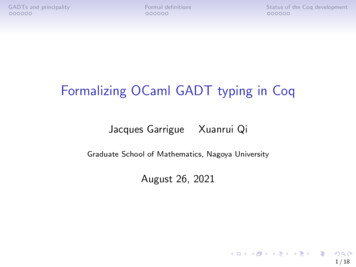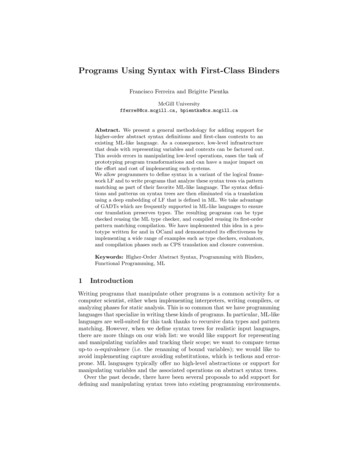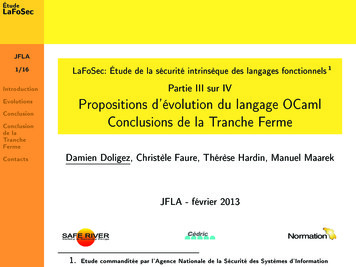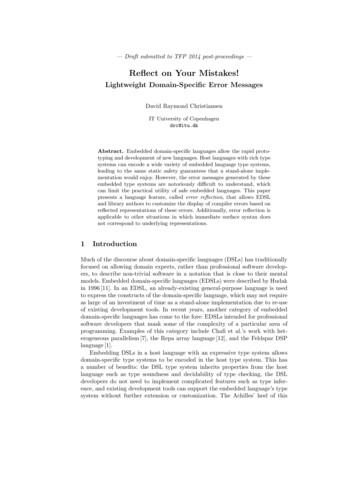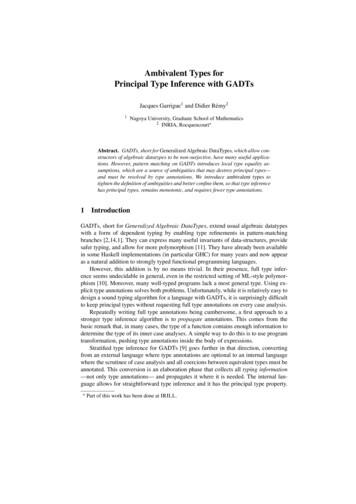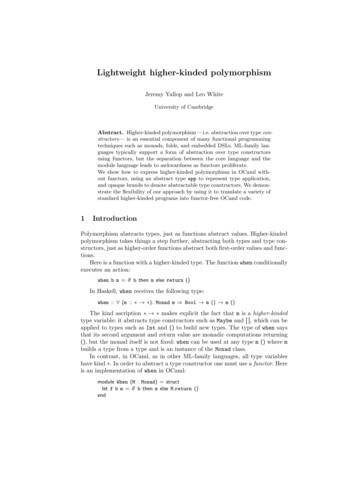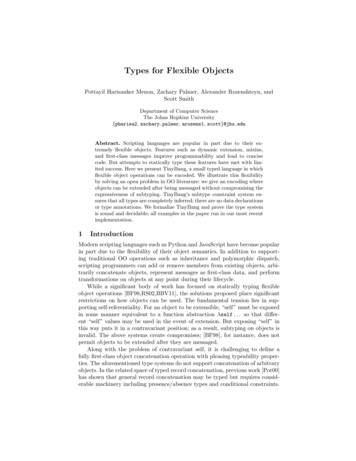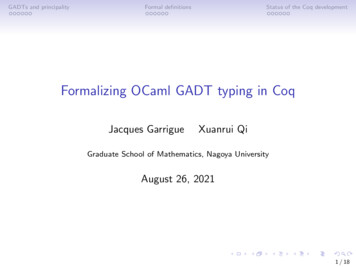
Transcription
GADTs and principalityFormal definitionsStatus of the Coq developmentFormalizing OCaml GADT typing in CoqJacques GarrigueXuanrui QiGraduate School of Mathematics, Nagoya UniversityAugust 26, 20211 / 18
GADTs and principalityFormal definitionsStatus of the Coq developmentOCaml, GADTs and principality Principality of GADT inference is known to be difficult. OCaml proven to be principal thanks to ambivalent types,which allow to detect ambiguity escaping from a branch[Garrigue & Rémy, APLAS 2013].type ( , ) eq Refl : ('a,'a) eq;;let f (type a) (w : (a,int) eq) (x : a) (* coherent *)let Refl w in if x 0 then x else x ;;val f : ('a, int) eq - 'a - 'a(* Principal for OCaml, rejected by GHC as ambiguous *)let g (type a) (w : (a,int) eq) (x : a) (* ambiguous *)let Refl w in if x 0 then x else 0 ;;Error: This instance of int is ambiguous:it would escape the scope of its equation2 / 18
GADTs and principalityFormal definitionsStatus of the Coq developmentAmbivalent types in a nutshell Types that rely on GADT equations are represented asambivalent types, which are a form of intersection types. Ambivalent types are only valid when equations are available,but their reliance on equations is implicit.let f (type a) (w : (a,int) eq) (x : a) let Refl w in (* add the equation a int *)if x 0(* this x has ambivalent type a int *)then x else x(* but these have only type a *)(* Hence the result is of type a *)val f : ('a, int) eq - 'a - 'alet g (type a) (w : (a,int) eq) (x : a) let Refl w in if x 0then x(* this x has type a *)else 0(* but 0 has type int *)(* The result has type a int, which becomes ambiguous *)Error: This instance of int is ambiguous3 / 18
GADTs and principalityFormal definitionsStatus of the Coq developmentSoundness and principality of inferenceOCaml and Haskell (GHC) differ in their handling ofUnification under GADT equations. In Haskell, unification under a GADT equation cannot involvevariables from outside (OutsideIn). In OCaml, this is allowed as long as the equation is notrequired for the unification (ambivalence).Relying on ambivalence is sound with respect to in-place unification tracks whether local unifications are valid outside. ensures principality of inference alternative types are rejected.4 / 18
GADTs and principalityFormal definitionsStatus of the Coq developmentDisambiguation Type annotations hide the ambivalence, by separating innerand outer types. This solves ambiguities. The following are valid:let g (type a) (w : (a,int) eq) (x : a) let Refl w in (if x 0 then x else 0 : a) ;;val g : ('a, int) eq - 'a - 'alet g (type a) (w : (a,int) eq) (x : a) let Refl w in (if x 0 then x else 0 : int) ;;val g : ('a, int) eq - 'a - intOCaml lets you write the annotation outside if your prefer.5 / 18
GADTs and principalityFormal definitionsStatus of the Coq developmentBut is it really principal?When looking for reduction rules validating subject reduction, wecame upon the following example:let f (type a b) (w1 : (a, b - b) eq)(w2 : (a, int - int) eq) (g : a) let Refl w1 in let Refl w2 in g 3;;val f : ('a, 'b - 'b) eq - ('a, int - int) eq - 'a - 'blet f (type a b) (w1 : (a, b - b) eq)(w2 : (a, int - int) eq) (g : a) let Refl w2 in let Refl w1 in g 3;;val f : ('a, 'b - 'b) eq - ('a, int - int) eq - 'a - int Changing the order of equations changes the resulting type. Bug in the theory: the ambivalence of g is not propagated tothe result of the application g 3, failing to detect ambiguity.6 / 18
GADTs and principalityFormal definitionsStatus of the Coq developmentBut is it really principal?When looking for reduction rules validating subject reduction, wecame upon the following example:let f (type a b) (w1 : (a, b - b) eq)(w2 : (a, int - int) eq) (g : a) let Refl w1 in let Refl w2 in g 3;;val f : ('a, 'b - 'b) eq - ('a, int - int) eq - 'a - 'blet f (type a b) (w1 : (a, b - b) eq)(w2 : (a, int - int) eq) (g : a) let Refl w2 in let Refl w1 in g 3;;val f : ('a, 'b - 'b) eq - ('a, int - int) eq - 'a - int Changing the order of equations changes the resulting type. Bug in the theory: the ambivalence of g is not propagated tothe result of the application g 3, failing to detect ambiguity.6 / 18
GADTs and principalityFormal definitionsStatus of the Coq developmentProving a fix in Coq We already proved soundness and principality for anotherfragment of OCaml, using a graph representation of types[Garrigue 2014, Structural Polymorphism].α :: κ; x : σ M : αHere κ’s are kinds, which describe nodes. By enriching the information in kinds with rigid variable paths,we can represent correct ambivalence. Principality is hard to prove, but subject reduction is already agood benchmark for a well-behaved type system.7 / 18
GADTs and principalityFormal definitionsStatus of the Coq developmentKinds and environments Kinds are constraints on a node, representing the graphstructure: α (β γ) a translates toα :: ( , {dom 7 β, cod 7 γ})a , β :: a.dom , γ :: a.cod α GrammarψCκrτQKσΓθ:: :: :: :: :: :: :: :: :: :: eq . . . (ψ, {l 7 α, . . . })C r a r .lr τ τ eq(τ, τ ) Q, τ τ K , α :: κ ᾱ.K α Γ, x : σ[α 7 α′ , . . . ]abstract constraintgraph constraintkindrigid variable pathtree typeequationskinding environmenttype schemetyping environmentsubstitution8 / 18
GADTs and principalityFormal definitionsStatus of the Coq developmentTerms and Judgments Well-formednessQ; K κQ KQ; K σQ; K Γ Graph type instance of a tree type: TermsM :: K θ : K′K τ :αx c λx.M M M let x M in M(M : τ )type annotationReflwitness introductiontype a.Mrigid variable introductionuse M : eq(τ, τ ) in M witness elimination Typing judgmentQ; K ; Γ M : αTyping implies both Q K and Q; K Γ.9 / 18
GADTs and principalityFormal definitionsStatus of the Coq developmentExamplelet f (type a) (w : (a,int) eq) (x : a) let Refl w in if x 0 then x else xcan be encoded asf type a.λw .λx.let x (x : a) inuse w : eq(a, int) in ifpos x x xwhereifpos : α1 :: int , β :: ,α :: ( , {dom 7 α1 , cod 7 α2 }),α2 :: ( , {dom 7 β, cod 7 α3 }),α3 :: ( , {dom 7 β, cod 7 β}) α β.int β β β10 / 18
GADTs and principalityFormal definitionsStatus of the Coq developmentSelected typing rulesUseGCVarAppQ; K ; Γ M1 : α1K eq(τ1 , τ2 ) : α1Q, τ1 τ2 ; K ; Γ M2 : αQ; K ; Γ use M1 : eq(τ1 , τ2 ) in M2 : αQ; K , K ′ ; Γ M : α FVK (Γ, α) dom(K ′ ) Q; K ; Γ M : αQ KQ; K Γ x : ᾱ.K0 α ΓQ; K ; Γ x : θ(α)K , K0 θ : KQ; K ; Γ M1 : αQ; K ; Γ M2 : α2α :: ( , {dom 7 α2 , cod 7 α1 })r KQ; K ; Γ M1 M2 : α111 / 18
GADTs and principalityFormal definitionsStatus of the Coq developmentDetecting ambiguity Using Var, App, and GC, we can show thata int; K , β :: a ; Γ , x : α :: a α ifpos x x x : βso that we can apply Use. On the other hand, a minimal derivation for g 3 inlet g (g : a) in use w : eq(a, int int) in g 3would bea int int; K , β :: int,a.cod ; Γ, g : α :: a α g 3 : βwhich becomes ambiguous when Use removes a int int.12 / 18
GADTs and principalityFormal definitionsStatus of the Coq developmentCoq development Based on “A certified implementation of ML with structuralpolymorphism and recursive types” [Garrigue 2014]. Itself based on Arthur Charguéraud’s development, usinglocally nameless cofinite quantification (“EngineeringMetatheory” [Aydemir et al. 2008]). Avoided unification in the type system by interpreting Q asthe set of its (rigid) unifiers. Finished proofs of subject reduction for following rules:(λx.M) Vlet x V in Mc V1 . . . Vn(M1 : τ2 τ1 ) M2(M1 : r ) M2use Refl : eq(τ1 , τ2 ) in M M[V /x]M[V /x]δc (V1 , . . . , Vn )(M1 (M2 : τ2 ) : τ1 )(M1 (M2 : r .dom) : r .cod)M13 / 18
GADTs and principalityFormal definitionsStatus of the Coq developmentRelation to principality Subject reduction and principality are independent properties. For ML-like type systems, principality is usually thecombination of:Monotonicity A type derivation is still valid using a stronger Γ(where types are more polymorphic).1Most General Unifier Unification of types admits a mostgeneral solution. Existence of MGU relies on the ability to decompose types,which is also exactly what we needed to prove subjectreduction for annotated applications.(M1 : r ) M2 (M1 (M2 : r .dom) : r .cod)1OutsideIn does not satisfy monotonicity, and is not strictly principal14 / 18
GADTs and principalityFormal definitionsStatus of the Coq developmentRemaining work Prove type soundnessSimpler to use translation into an explicit type system.Some formalization of soundness of GADTs already exists[Ostermann & Jabs, ESOP 2018] Prove principalityThis is hard, but a first step is existence of MGU. Soundness of type inferenceAnother role of ambivalence is to ensure the soundness ofinference. It would be interesting to prove it for weaker(non-principal) versions of the type system.15 / 18
GADTs and principalityFormal definitionsStatus of the Coq developmentFurther applications Graph types are also used inside OCaml to enforce theprincipality of first-class polymorphism and first-class modules.module type Id sig val id : 'a - 'a end;;fun (m : (module Id)) - let module M (val m) in M.id m;;- : (module Id) - (module Id) fun fun m - ignore (m : (module Id));let module M (val m) in M.id m;;Warning: this module unpacking is not principal. Basic idea: a type is known if it is not shared with Γ. Extension should be straightforward.16 / 18
GADTs and principalityFormal definitionsStatus of the Coq developmentOther approaches to soundnessWe are also investigating other ways to make OCaml typeinference more robust.Directly by making internal data-structures abstract, andhaving unification follow precise laws. Ultimately, thetype inference algorithm should look like its formaldefinition. (with Takafumi Saikawa)Indirectly by translating the type annotated source tree intoGallina programs, and relying on Coq’s typesoundness.https://www.math.nagoya-u.ac.jp/ garrigue/cocti/17 / 18
GADTs and principalityFormal definitionsStatus of the Coq developmentSoundness by (x)[[P]]([[x]])If for all P : τ τ ′ and x : τ P translates to [[P]], and [[P]] : [[τ τ ′ ]] x translates to [[x]], and [[x]] : [[τ ]] [[P]] applied to [[x]] evaluatesto [[P(x)]]then the soundness of Coq’s typesystem implies the soundness ofOCaml’s evaluation18 / 18
Formalizing OCaml GADT typing in Coq Jacques Garrigue Xuanrui Qi Graduate School of Mathematics, Nagoya University August 26, 2021 1/18. GADTs and principality Formal definitions Status of the Coq development OCaml, GADTs and principality Principality of GADT inference is known to be difficult.
